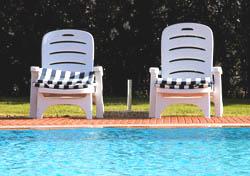Pool Regulations
The Swimming Pool Safety Act, section 115920 of the California Health and Safety Code, became effective January 1, 1998 and involves child safety around swimming pools. Effective January 1, 2007, homeowners are required to install at least one of seven specified drowning prevention safety features for new or remodeled pools. In addition, to help eliminate safety hazards on existing pools and spas, whenever a building permit is issued for remodeling or modifications of an existing pool or spa, installations of pool anti-entrapment covers are required.
Swimming Pool Safety Requirements
What is required for barrier methods?
New and remodeled swimming pools, toddler pools and spas must be isolated from the home by one of the following seven methods:
- Enclosure – An approved fence, wall, or barrier serving as an enclosure that separates the pool from the house; or,
- Removable Mesh Fencing – The pool shall incorporate removable mesh pool fencing that meets American Society for Testing and Materials (ASTM) Specifications F 2286 standards in conjunction with a gate that is self-closing and self-latching and can accommodate a key lockable device; or,
- Safety Cover – The pool shall be equipped with an approved safety pool cover that meets all requirements of the ASTM Specifications F 1346; or,
- Exit Alarms – The residence shall be equipped with exit alarms on those doors providing direct access to the pool; or,
- Self-Closing, Self-Latching Doors – All doors providing direct access from the home to the swimming pool shall be equipped with a self-closing, self-latching device with a release mechanism placed no lower than 54 inches above the floor; or,
- Swimming Pool Alarms – Swimming pool alarms that, when placed in pools, will sound upon detection of accidental or unauthorized entrance into the water. These pool alarms shall meet and be independently certified to the ASTM Standard F 2208 “Standards Specification for Pool Alarms” which includes surface motion, pressure, sonar, laser, and infrared type alarms. Swimming pool alarms shall not include swimming protection alarm devices designed for individual use, such as an alarm attached to a child that sounds when the child exceeds a certain distance or becomes submerged in water; or,
- Other Means of Protection – Other means of protection, if the degree of protection afforded is equal to or greater than that afforded by any of the devices set forth above, and have been independently verified by an approved testing laboratory as meeting standards for those devices established by the ASTM or the American Society of Mechanical Engineers (ASME).
Note: Per Rocklin city zoning code section 17.08.150, a five-foot fence with self-latching gates shall surround all pools.
What are the requirements for an enclosure?
Enclosures are intended to keep children from entering the pool area and must meet the following minimum construction requirements:
- Enclosures must be at least 5′ (five feet) high.
- The maximum gap between the bottom of the enclosure and the ground must not exceed 2″ (two inches).
- Gaps or voids in the enclosure must be less than 4″ (four inches).
- The enclosure shall be free of handholds or footholds that could allow a child below the age of five to climb into the pool area.
- Enclosure access gates must open away from the pool area, be equipped with a self closing and self latching device with a release mechanism placed not lower than 60″ (sixty inches) above the ground.
- Pool Regulations
What about hot tubs and spas?
Hot tubs or spas that have a locking safety cover that complies with the American Society for Testing Materials-Emergency Performance Specifications (ASTM-ES 13-89) are exempt from the above barrier requirements.
What types of swimming pool safety upgrades are required?
To eliminate safety hazards on existing pools and spas, California Health and Safety Code 115928 requires installations of pool anti-entrapment covers whenever a building permit is issued for the remodel or modification of an existing swimming pool, existing toddler pool or existing spa at a single family residence. The permit shall require that the suction outlet of the existing swimming pool, toddler pool, or spa be upgraded so as to be equipped with an anti-entrapment cover meeting current standards of the American Society for Testing and Materials (ASTM) or the American Society of Mechanical Engineers (ASME), ASME/ANSI Standard A 112.19.8.
Key Definitions A. “Swimming pool” or “pool” means any structure intended for swimming or recreational bathing that contains water over 18 inches deep. “Swimming pool” includes in-ground and above-ground structures and includes, but is not limited to, hot tubs, spas, portable spas, and non-portable wading pools. B. “Enclosure” means a fence, wall, or other barrier that isolates a swimming pool from access to the home. C. “Approved safety pool cover” means a manually or power-operated safety pool cover that meets all of the performance standards of the American Society for Testing and Materials (ASTM), in compliance with standard F1346-91. D. “Exit alarms” means devices that make audible, continuous alarm sounds when any door or window that permits access from the residence to the pool area that is without any intervening enclosure, is opened or is left ajar. Exit alarms may be battery operated or may be connected to the electrical wiring of the building.
Where can I view the Swimming Pool Safety Act, section 115920 or section 115928 of the California Health and Safety Code?
Please visit the California Law web page.



